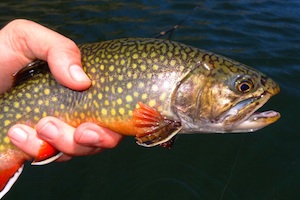Brook Trout Features and Size

 Brook trout are brightly marked and colored. In fact, they’re so distinctly colored that they’re most easily identifiable of all freshwater fish in North American waters.
Brook trout are brightly marked and colored. In fact, they’re so distinctly colored that they’re most easily identifiable of all freshwater fish in North American waters.
3 External Charr Features
If you ever get into a disagreement with a trout expert claiming that the Brook Trout is actually a trout, there are 3 features you can point to that clearly identify it as a Charr.
1) The Brook Trout have white pipings on the outer edge of fin, with the exception of the caudal fin. This is a clear Charr characteristic.
2) The Brook Trout has a narrow black stripe on the interior of the white leading edges on its fins – another clear Charr characteristic. A trout on the other hand, has the body spots of a trout with a light background. This is a complete reversal of a charr.
3) Charr have very small scales leaving them feeling very smooth. Another Charr characteristic. Trout on the other hand, have large scales.
The Brook Trout sports a vestigial adipose fin on its back. It also has paired pectoral and pelvic fins and a singular anal fin, just posterior of the vent.
Coloration can vary greatly, depending on the environment they’re found in. And it’s possible to determine if it was raised in a hatchery by its color alone.
Brook Trout Colors
- Light, metallic blue for saltwater and those Brook Trout that leave natal streams and spend part of the year in large, deep, clear lakes.
- Dark brown and yellowish bodies in trout trapped behind beaver dams.
In both sexes body colors intensify during spawning and are more pronounced in males.
Size & Age
Brook Trout have a semi-average life expectancy. Most Brook trout live to the age of 4 or 5 years with 10 years being considered to be very old for the Brook Trout. This pales compared to the 20 to 30 years old that the Arctic Charr can live. Although it’s not that short compared to other trout.
And let’s not get into sea turtles … they even outlive humans!
The average length of fish caught is between 7 and 10 inches long. They weigh about half a pound with the largest caught not being much more than 2 pounds.
These are not large fish.
Brook Trout Record
The all-tackle record is 14 pounds, 8 ounces. This obviously seems to go against what I have written above but keep in mind that their environment is under pressure and much of their distribution is located in areas where there is a high human population density.
That record Brook Trout was caught in 1916 and reached a length of 31 inches.


